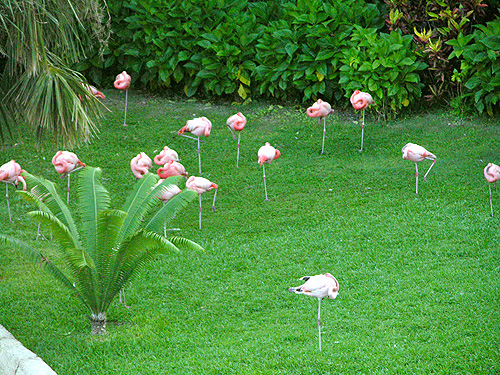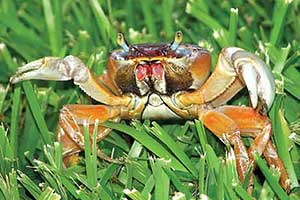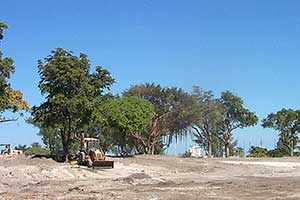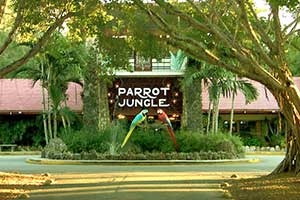
The Environmental Lawn

To most people a lawn is an open area that surrounds a home, and is planted as a monoculture with a single species of grass. Often these lawns are maintained at great cost and with much effort. Nationwide the cost of irrigation, fertilizer, pesticides, and mowing runs into an astronomical amount of money. A very lucrative industry has grown up around the myth of creating and maintaining the “perfect” green lawn.
The term “Industrial” lawn was coined in the first edition of “Redesigning the American Lawn” published in 1993 by Yale University Press. It was a primer toward sustainable lawn management and very applicable to our situation here in South Florida.
Because of our climate and soil conditions most lawns in our area consist of one of the following exotic species of grass; the very common lawn grass “St. Augustine” Stenotaphrum secundatum, Bermuda grass Cynodon spp., the tough expressway grass Bahia, or one of the Zoysia species. Some of these grasses can be very difficult to grow and keep as a perfect monoculture. Fungal problems, chinch bugs or army worms are always ready to take advantage of the lush grass or a fast growing “weed” is always there outgrow and take over the lawn.
Did you know that the fatal palm disease Lethal Yellowing (LY) is vectored by an insect called a Planthopper, Myndus crudus and that the immature stages of this insect develop on all common turf grasses popular in Florida? They feed upon palms and transmit LY as adults. Dicotyledonous (dicots) ground covers that have been tested do not support the development of this insect. Dicots are considered the woody plants and grasses are considered monocots (monocotyledonous).
Add up the cost of maintaining your lawn for an entire year. Do you pay a service to come and cut, spray and fertilize or do you own your own lawn mower and fight the battle of the Industrial lawn yourself?
There is another option to growing and financing this Industrial Lawn. That option is the Environmental Lawn. This is a garden that requires no input of fertilizers or pesticides. It can be home to many species of grasses, sedges, or even tiny dicots. One of the functions of an Environmental Lawn (aside from the aesthetic) is a place where beneficial insects can gather pollen and nectar from the tiny dicot flowers that abound in this habitat. Many of the tiny parasitic wasps that prey upon scale insects, caterpillars, and other plant pests take nectar from plants with tiny flowers that present small, open nectaries. Many species of wasps are very dependent upon food plants to realize their high reproductive potential thereby enabling them to control a greater percentage of our plant pests.
The Environmental Lawn also functions as a butterfly garden. The plants found in this habitat are very attractive for nectar gathering and egg laying. Throughout the year when there is a profusion of tiny flowers in bloom, dozens of butterflies can be seen feeding from the flowers.
The lawns at Parrot Jungle Island (PJI) were all grown as Environmental lawns. The area that is called Flamingo Lake is approximately one acre with half of the area lawn. This exhibit was designed as a basin with the lake at the bottom so that the flamingos are protected from hurricanes. The wind will blow above them when they seek refuge in the lake during a storm. With the lawn on a slope, any chemicals or fertilizers that are put onto the lawn will eventually runoff into the lake potentially harming the fish and other animals that live in the water. The Picnic area next to the Children’s playground is another half acre of lawn. This is an area the public has constant access to and any pesticides or fertilizers put onto this lawn can possibly expose the public to harmful chemicals. These lawn areas are also only eight feet or so above the water table. Many fertilizers can leach out of the root zone quite rapidly and enter the water table; this causes pollution and is not very Eco-efficient (Eco-efficiency is fundamentally a ratio of some measure of economic value added to some measure of environmental impact). The Environmental Lawn uses less water, less or no chemicals, and less labor; this is Eco-efficient.
A decision was made when PJI opened three years ago to grow lawns (actually the entire landscape) that would not use pesticides, fungicides, nematicides, or commercial fertilizers. These lawns are now very attractive and green. They are not would be considered perfect by the standards of some people, but they are perfect when considered from an environmental and ecological point of view.
Establishing an Environmental Lawn in South Florida can be easily done with patience and common sense. Stop or slow down your fertilizing and spraying; see what will grow in your garden.
Jeff Shimonski
ISA Certified Municipal Arborist FL-1052AM
August 2006





 About Theme Parks, Zoos & Tropical Design
About Theme Parks, Zoos & Tropical Design Integrated Pest Management in a Zoological Theme Park, Wing Beats the Journal of the American Mosquito Association
Integrated Pest Management in a Zoological Theme Park, Wing Beats the Journal of the American Mosquito Association The Environmental Lawn
The Environmental Lawn Design with Integrated Pest Management
Design with Integrated Pest Management Creating Islands in Aquatic Ecosystems
Creating Islands in Aquatic Ecosystems Building a New Jungle - Contouring the Site and Creating a Tree Canopy
Building a New Jungle - Contouring the Site and Creating a Tree Canopy Watson Island - Remaking History
Watson Island - Remaking History The Gardens at Parrot Jungle Island, The First Year
The Gardens at Parrot Jungle Island, The First Year Parrot Jungle & Gardens
Parrot Jungle & Gardens